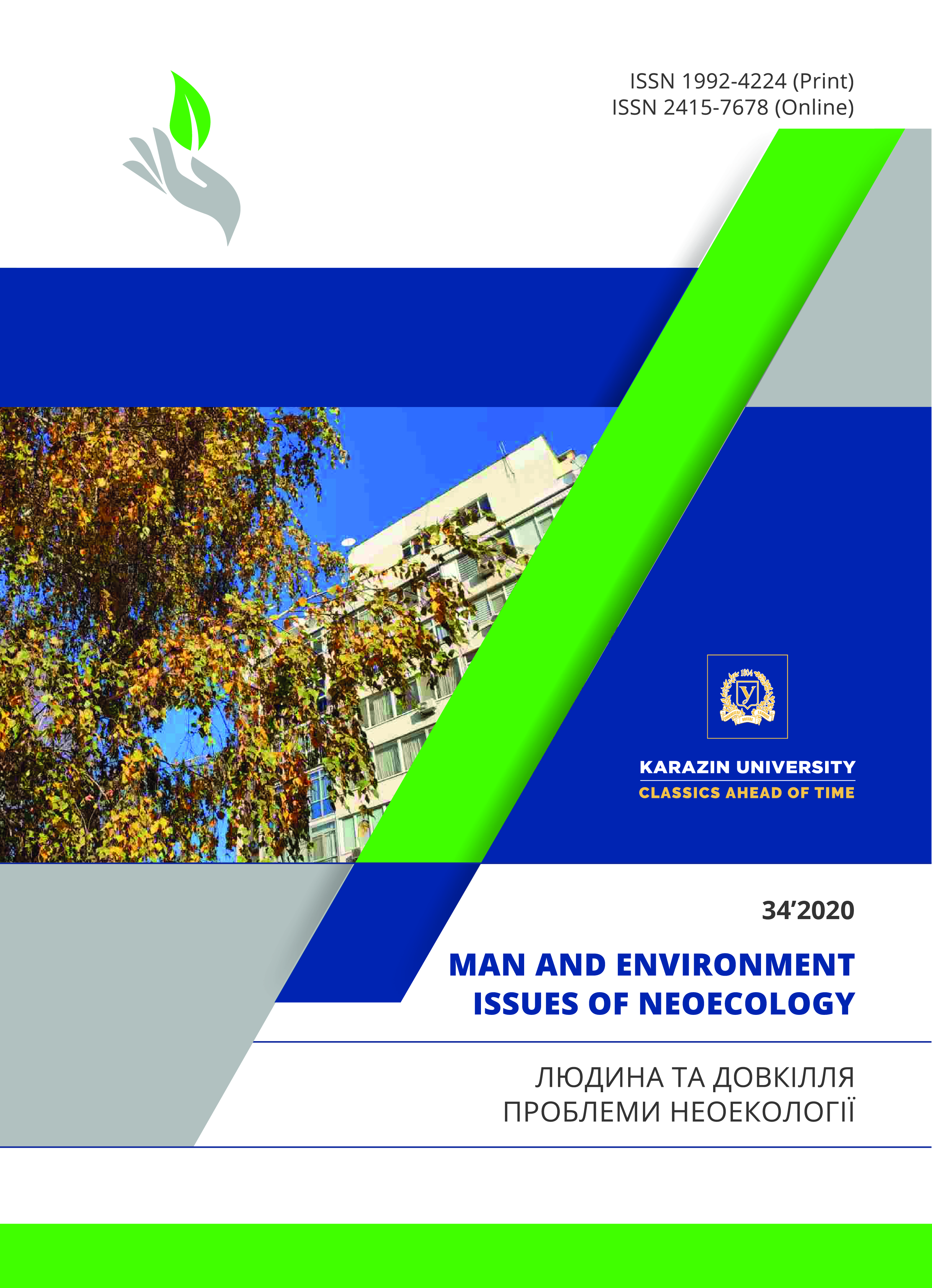Forecast of Changes in the Condition of the Beach Condition of the City of Mykolaiv Under Influence Natural Factors
Abstract
Purpose. The forecast of a condition of a beach of the city of Nikolayev, the general offers of measures of its protection against degradation.
Methods. The forecast of a condition of a beach of the city of Nikolayev is made with use of methods of mathematical statistics and mathematical modeling, the comparative analysis, cartographic and graph analytical researches.
Results. The beach of the city of Nikolayev is a strip of coast of the big water object where features of reforming of coasts of reservoirs and the rivers united. The location of the beach on the convex shore of the Bug estuary creates the conditions for the accumulation of sand due to the coastal movement of sediments downstream. However, the width of the estuary and the depth contribute to the formation of wind turbulence in the sector S-Z-Pn, which can destroy the beach. On the beach during the spring floods or in severe down pouring phenomena, long-coastal movement of sands in large volumes is possible depending on the duration of strong currents, but the transportation of sediments along the beach does not significantly affect changes in the outline of its coastal slope.
Significant destruction of the beach can occur from storms of rare recurrence in the sector S-SW. Western frontal storms form a profile of relative dynamic equilibrium and contribute to the movement of sands to depth. When the waves approach at an angle to the shoreline is the longitudinal transport of sand. Protection of the beach from erosion can be done by passive or active methods. Further research will focus on a quantitative analysis of the scenario of sand movement along the beach with its accumulation on the protruding part of the beach (point C) and washing away the accumulated sand to a depth under the influence of western storms.
Conclusion. Without acceptance of special measures for protection the beach of Nikolayev in the future will degrade.
Downloads
References
Fokina N.A. Natural factors of abrasion processes. Retrieved 2020, September 21 from httр://dsраce.nbuv.gov.uа/bitstreаm/hаndle/123456789/15100/6-Fokinа.рdf. (In Russian).
Grishanin K.V. (1979). Channel flow dynamics. Leningrad: Hydrometeorological Publ. Retrieved from http://www.cawater-info.net/library/rus/hist/grishanin.pdf (In Russian).
Baryshnikov N.B. (2003). Hydraulic resistance of river channels. Tutorial. St. Petersburg: Publ. RGGMU. Retrieved from http://elib.rshu.ru/files_books/pdf/img-504160857.pdf/ (In Russian).
Vyhovanec G.V., Murkalov A.B., Stojan A.A. (2014). Dynamic dimensional stability of sandy beaches. ONU Bulletin. Series: Geographical and geological sciences, 19(1), 53-68. Retrieved from https://elibrary.ru/item.asp?id=23918651 (In Russian).
Vykhovanets G.V., Pankratenkova D.O. (2018). The influence of the anthropogenic factor on the cur-rent state of accumulative landforms in the North-Western part of the Black Sea. ONU Bulletin. Series: Geographical and geological sciences, 23(1), 11-31. Retrieved from https://docs.google.com/viewerng/viewer?url=https://vdocuments.mx/google-read-er?url%3D0134e884efae48a53203ad479588edc58d86e3d58408f6a8fb935a53a61c370b7badadefacf467661908920afd9b8c6cf089ceb4a31db14aa4aaffe008fd6fc3OIJ/GIaMoGEfa0onrl7wucaIt84ta/ClRzs1YPkJOwZzYJIKX3QGg+6xrJ4LRHPj (In Russian).
Verbitsky Yu.S., Yamskikh G.Yu. (2015). Changes in the coastal zone of the Krasnoyarsk reservoir in the area of the village of Primorskoe. Bulletin of the Kemerovo State University, 2(61), 78-83. Re-trieved from https://cyberleninka.ru/article/n/izmeneniya-pribrezhnoy-zony-krasnoyarskogo-vodohranilischa-v-rayone-poselka-primorskoe/viewer (In Russian).
gnatov, E.I., Zemlyanov, I.V., Sanin A.Ju., Borshchenko E. V. & Tersky P.N. (2018). Application of computational methods to study the dynamics of the shores of Lake Onega and their development. Proceedings of the Karelian Scientific Center of the Russian Academy of Sciences, (3), 84-93.. Re-trieved from https://www.researchgate.net/publication/325203336 (In Russian).
Leont'ev, I.O. (2001). Coastal dynamics: waves, currents, sediment flows. Moscow: GEOS Publ. Re-trieved from https://www.twirpx.com/file/2166978/ (In Russian).
Ministry of Construction and Housing of the Russian Federation. (2017). SP 277.1325800.2016: Set of rules. Marine coastal protection structures. Design rules. Retrieved from: http://docs.cntd.ru/document/456055940 (In Russian).
TOV «Inzhenernyi tsentr «Heobest». (2019). Technical report on engineering and geological surveys at the site: "New construction of a shore protection structure along the street. Azure in the city of Ni-kolaev ». Dnipro. (In Ukrainian).
All-union scientific and research institute of water supply, sewerage, hydraulic facilities and engineering hydrogeology (VNII VODGEO) Gosstroy of the USSR. (1984). Recommendations for the design of self-cleaning buckets near flooded water intakes. Mosсow. Retrieved from https://pdf.standartgost.ru/catalog/Data2/1/4293764/4293764750.pdf (In Russian).
Ministry of Architecture and Construction of the Republic of Belarus (2011). Technical Code of Prac-tice: 45-4.01-198-2010 (02250): Intake structures from surface sources. Design rules. Minsk. Re-trieved from https://www.twirpx.com/file/2153721/ (In Russian).
Gosstroy of the USSR (1983). Building regulations: 2.06.04-82*: Loads and impacts on hydraulic structures (wave, ice and from ships). Moscow. Retrieved from http://docs.cntd.ru/document/1200000256 (In Russian).
Lappo, D.D., Strekalov, S.S. & Zav'jalov V.K. (1990). Loads and effects of wind waves on hydraulic structures. Theory. Engineering Methods. Leningrad: VNIIG them B.E.Vedeneeva Publ. Retrieved from https://www.twirpx.com/file/1461764/ (In Russian).
Authors reserve the right of attribution for the submitted manuscript, while transferring to the Journal the right to publish the article under the Creative Commons Attribution License 4.0 International (CC BY 4.0). This license allows free distribution of the published work under the condition of proper attribution of the original authors and the initial publication source (i.e. the Journal)
Authors have the right to enter into separate agreements for additional non-exclusive distribution of the work in the form it was published in the Journal (such as publishing the article on the institutional website or as a part of a monograph), provided the original publication in this Journal is properly referenced
The Journal allows and encourages online publication of the manuscripts (such as on personal web pages), even when such a manuscript is still under editorial consideration, since it allows for a productive scientific discussion and better citation dynamics (see The Effect of Open Access).





